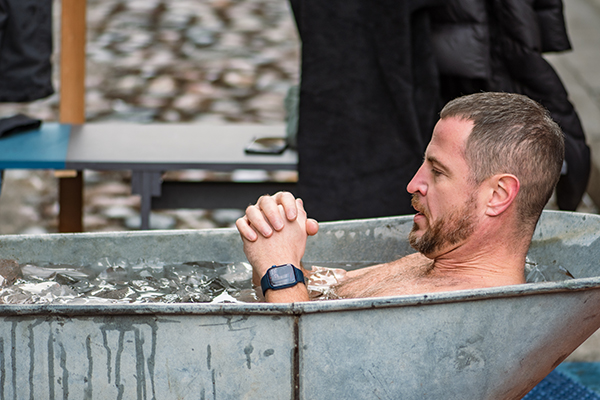In the world of sport and physical training, muscle recovery is as important as the exercise itself. But how effective is cold water immersion in mitigating muscle damage induced by strength training? A recent study published in the European Journal of Sport Science sheds light on this issue, exploring how this technique can be a key tool for athletes and coaches looking to optimize performance and prevent injury.
Strength training is a very popular form of physical activity, especially among beginner athletes. It is considered accessible and effective for improving muscle strength and endurance. However, it is important to bear in mind that eccentric exercises, which involve stretching the muscles while resisting force, can cause exercise-induced muscle damage (EIMD) in inexperienced people.
What is the challenge of exercise-induced muscle damage?
EIMD is a common phenomenon, especially in activities involving eccentric contractions, such as weightlifting or sprints. This type of damage can manifest as delayed onset muscle soreness (DOMS), reduced muscle strength, and increased enzyme markers such as creatine kinase (CK) and myoglobin (Mb). These alterations not only affect physical performance, but also increase the risk of injury, especially in vulnerable muscle groups such as the hamstrings.
Previous studies have shown that EIMD can last several days, significantly affecting the ability of athletes to train and compete. To minimize injury and speed recovery after intense exercise, different recovery strategies have been used, such as cryotherapy. This strategy involves applying cold to the body to reduce inflammation and muscle pain.
Cold water immersion and muscle recovery
Cold water immersion, also known as whole-body cryotherapy (WBC), is a popular recovery strategy that involves immersing the limbs or trunk in cold water at a temperature of approximately 8-15 °C for a few minutes. Studies have shown that CWI is beneficial for the recovery of muscle strength in the legs, especially when applied immediately after exercise and in the following 24-72 hours.
However, some studies have found negative effects of CWI on increasing muscle strength in men. On the other hand, it has been observed that CWI is more effective than other recovery strategies, such as massage, in reducing fatigue and muscle pain in male and female athletes. Although CWI has been widely used in athletic populations, there is a lack of research on its effects on healthy adult women who perform more intense exercise. With this in mind, the study entitled «Effect of cold-water immersion treatment on recovery from exercise-induced muscle damage in the hamstring» investigates the effects of CWI treatment on the recovery of hamstring muscles after EIMD caused by maximum eccentric contraction exercise in female athletes.

How was the study conducted?
The study recruited eighteen healthy adult women aged between 21 and 27 who were randomly divided into two groups: a CWI group and a control group. Both groups performed a series of maximum eccentric contractions in the hamstrings of their non-dominant leg for five consecutive days. The CWI group received a 14-minute session of CWI treatment (at 14°C) after the eccentric contraction test, while the control group rested in a sitting position without receiving treatment.
Relevant results
It was observed that CWI treatment at a water temperature of 14 °C, in a sitting position and lasting 14 minutes, was beneficial for recovery from muscle damage induced by high-intensity exercise. Participants in the CWI group showed superior recovery responses compared to the control group after receiving CWI treatment for 5 consecutive days after eccentric contraction exercise. The CWI treatment sessions accelerated muscle strength recovery, reduced delayed onset muscle soreness (DOMS), restored hamstring flexibility and decreased plasma myoglobin (Mb) concentration.
Although this study provides strong evidence for the positive effects of CWI treatment on muscle recovery, the authors also recognize that there are some limitations in the research design. For example, chronic skeletal muscle adaptations and muscle protein synthesis rates were not explored. Therefore, they recommend that future research address these aspects to gain a more comprehensive understanding of the effects of CWI on muscle recovery.
These findings support the idea that CWI can be an effective strategy for muscle recovery after intense exercise. However, more research is needed to fully understand the effects of CWI in different populations and exercise conditions.
Continue your professional training
This study highlights the existing need for specific training for sports coaches and sports management. For this reason, the Universidad Internacional Iberoamericana (UNIB) offers you the opportunity to study the Master’s Degree in Physical Activity: Sports Training and Management. This master’s degree will allow you to deepen your knowledge in the practice and direction of physical training and all aspects related to the management of sports centers. Enroll in this master’s degree and take the leap towards a career full of opportunities. Make your passion for training become your profession!

